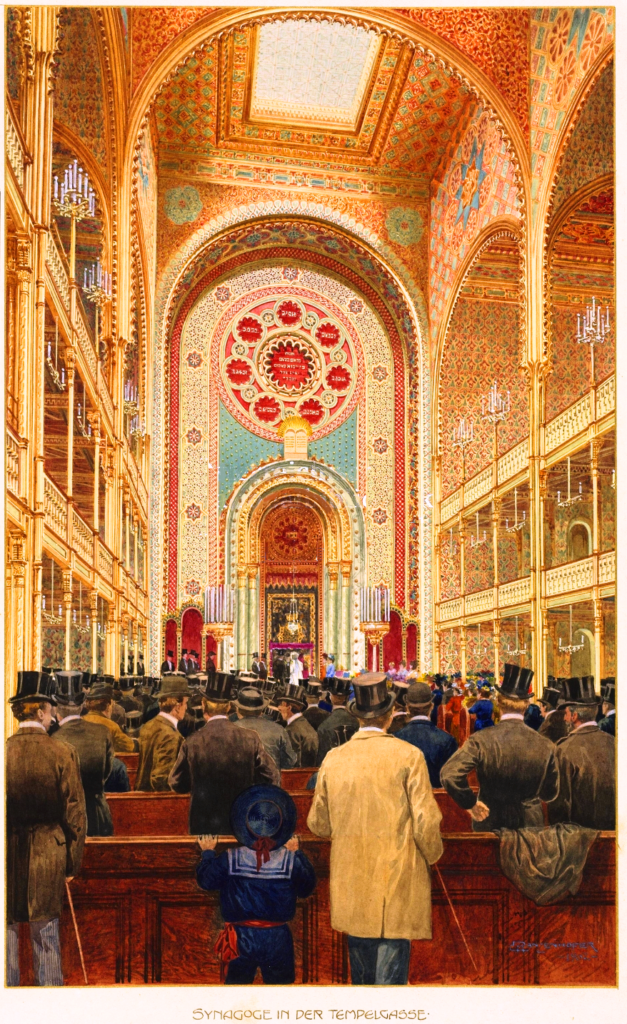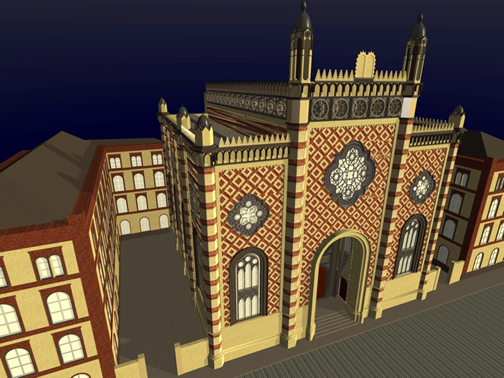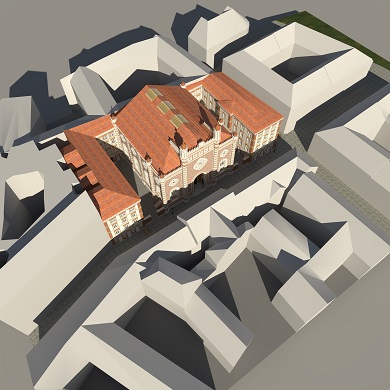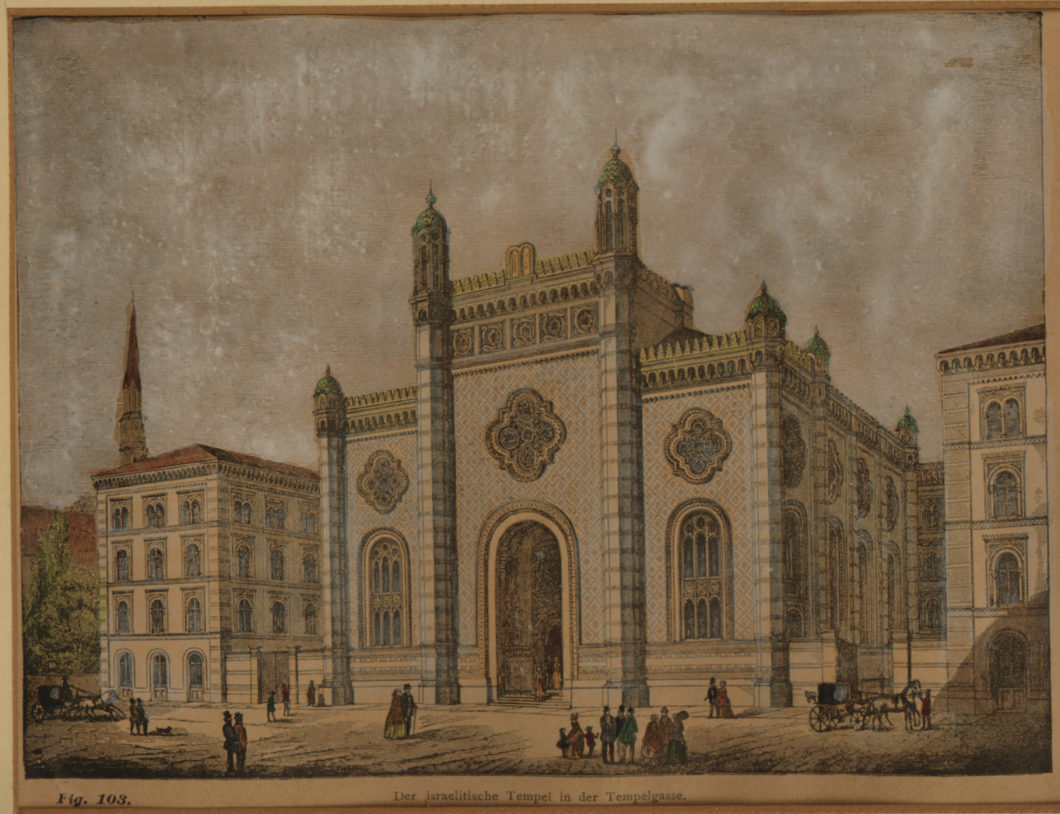Leopoldstädter Temple: A Lost Symbol of Jewish Vienna
The Leopoldstädter Temple once stood as the largest and most magnificent synagogue in Vienna. Located at Tempelgasse 5, in the city’s 2nd District, Leopoldstadt, it served as the spiritual and cultural heart of Vienna’s flourishing Jewish community.
History and Construction of the Temple
Built between 1854 and 1858, the synagogue was a response to the rapidly growing Jewish population. The older Seitenstettengasse synagogue could no longer accommodate the congregation. The Jewish community’s leaders wanted a more dignified, central place of worship, so that new arrivals would not need to open more small prayer rooms, which were viewed as obstacles to unifying the community. Architect Leopold Föster, who had designed a synagogue in Pest and a factory in Vienna, was commissioned to design the new building. The Leopoldstädter Temple in Vienna became an icon of that era.
The synagogue was built in a Classicist style, featuring a large cubic structure luxuriously decorated with oriental-style ornaments. With seating for 2,000 worshippers, it became a symbol of the self-confidence that Jewish residents had in their contribution to the city’s development. The inauguration, held on June 15, 1858, was celebrated not only by the Jewish community but also by non-Jewish neighbors. Senior politicians and dignitaries attended the ceremony, reflecting the growing liberal attitudes toward Jews in Vienna.
Architectural and Cultural Importance
The Leopoldstädter Temple stood out for its impressive size and architectural beauty. Its oriental-style decorations honored Jewish cultural traditions while blending them with Viennese grandeur. The temple reflected a period of rising integration and acceptance of Jewish citizens within Austrian society. This architectural wonder, the Leopoldstädter Temple, made Vienna proud.
Alongside the synagogue were two smaller adjoining buildings. The southern building housed the world-renowned library of the Israelitische Kultusgemeinde Wien (Jewish Congregation of Vienna), which was run by Dr. Bernhard Wachstein, a leading figure in Jewish academic literature. The building also contained living quarters for community officials. The northern building (located at 3 Tempelgasse) housed an assembly hall, apartments, a mikvah (ritual bath), and the Israelitisch-theologische Lehranstalt (Jewish Theological Academy). This made the temple not just a religious site, but a vibrant community center, known as the Leopoldstädter Temple Vienna to many.
Renovations and Damage
The synagogue underwent multiple renovations over the years. In 1898, architect Wilhelm Stiassny enhanced the interior with plasterwork, and in 1905, architect Oskar Marmoreck renovated both the street-facing and courtyard-facing sides of the building. In 1917, a fire caused damage to the synagogue, and restoration work continued until 1921. The resilience of the Leopoldstädter Temple Vienna was evident through these periods of reconstruction.
Notable Religious Leaders
The synagogue’s first preacher was the celebrated rabbi Adolf Jellinek, who spoke at its inauguration in 1858. Jellinek, a renowned orator, later served at the Stadttempel (City Temple). Following Jellinek, the congregation was led by notable figures like Dr. Moritz Güdemann, who became rabbi in 1866 and also later worked at the Stadttempel. In 1913, Dr. Max Grünwald became rabbi, gaining popularity for his sharp-witted sermons and his biographies of influential Viennese Jews. Many remember these leaders of the Leopoldstädter Temple Vienna for their significant contributions.
The last rabbi to serve at the Leopoldstädter Temple was Dr. Israel Taglicht, who succeeded Dr. Grünwald in 1932. After the death of Dr. David Feuchtwang in 1936, Rabbi Taglicht also became the chief rabbi of the Stadttempel.
Pogrom Night and Destruction
The synagogue’s tragic end came during the Pogrom Night (Kristallnacht). In October 1938, the temple was set on fire, and although the damage was initially contained, violence against Jewish institutions escalated. On the morning of November 10, 1938, the Gestapo seized the temple’s library, and shortly afterward, the synagogue’s interior was set ablaze. Civilians and SS units vandalized the temple, and by 10:02 a.m., the once-grand building had burned to the ground. In 1941, the ruins of the Leopoldstädter Temple in Vienna were cleared, and in 1951, the ground was flattened.
Present Day: A Memorial to the Past
Today, the site of the former Leopoldstädter Temple remains an empty lot. However, a memorial consisting of four original columns stands as a reminder of the once-imposing synagogue. The columns were reinstalled by architect Martin Kohlbauer to commemorate the temple’s significance. The Leopoldstädter Temple Vienna is fondly remembered through this memorial.
Although the synagogue is gone, a new Jewish community building, which includes a synagogue, an assembly room, and a mikvah, has been constructed at 3 Tempelgasse, on the site of the former north wing of the Leopoldstädter Temple.




